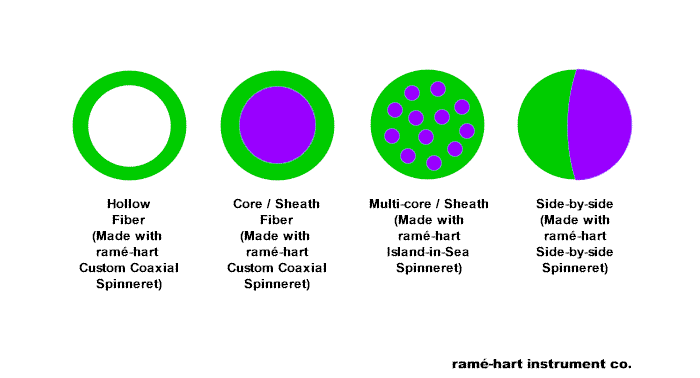|
Visit our website at
www.customspinnerets.com
|
|
Ten Advantages of Coaxial Electrospinning |
|
The first patent for electrospinning was
issued to J. F. Cooley in 1900. It wasn't until the 1930s, however, that
Anton Formhals developed the first commercial products using a method he
developed for producing electrospun yarns. During the 1960s, the British
physicist Geoffrey Ingram Taylor produced mathematical and theoretical
models of electrospinning and the eponymous Taylor cone. Since the
1990s, interest in electrospinning has accelerated exponentially. And
since the mid 2000s, interest in and the development of coaxial
electrospinning has been met with a comparable level of interest.
We'd like to detail ten advantages of coaxial electrospinning: 1. The human hair, despite its small cross-sectional diameter, is a rather complex material. The outer layer provides sheen and texture. Inner layers provide strength and flexibility. The inner cortex is made up of melanin which determines the color. Hair, which is made up of dead cells showing no biochemical activity outside of the hair follicle, is a complex and essential biomaterial.
In a similar manner, coaxial nanofibers offer a powerful core-sheath design allowing the producer to mix and match a variety of materials for the inner core and the outer shell that are optimized for the particular desired properties of the application at hand. This is a significant advantage over single material electrospun nanofibers. 2. Coaxial nanofibers are relatively easy to produce. There is no need for elevated temperatures, plasma treatment, vacuum, or advanced chemical formulations. 3. A wide array of electrospinning parameters allow the researcher additional flexibility in designing coaxial nanofibers that are optimized for a particular application. These parameters include: flow rate, the inner and outer gauges used in the spinneret, additional spinneret dimensions1, temperature, humidity, viscosity and surface tension of the flow materials, concentrations of solvents in the solutes, and so on. By manipulating these parameters, the fiber diameters can be tightly controlled. 4. In addition to core-sheath fibers, coaxial electrospinning can also produce hollow fibers. A non-electrospinnable material is used in the core. By controlling the flow rates, the fiber diameter and wall thickness can be controlled. 5. In biomedical applications, the coaxial nanofiber can be engineered to release one or more drugs at a very controlled rate. This feature lends itself to wound dressings and engineered biotissue. 6. Aligned coaxial nanofibers have proven useful in the production of nerve guide conduits used to repair damaged nerves.2 7. Coaxial nanofibers have proven promising in novel cancer treatments. In one study, polyvinyl alcohol is used to produce the core and chitosan - the shell of the electrospun material. The biocompatible nanofibers promote ovary cell attachment while precisely time-releasing doxorubicin, a chemotherapy drug.3 8. Water repellency while maintaining breathability is the holy grail of fabric design. PTFE is the most hydrophobic polymer in the universe. But it's difficult to electrospin because it's not very electrically conductive. However, by using a coaxial nanofiber design with an electrospinnable core and a Teflon shell, a nonwoven textile can be produced that exhibits superhydrophobicity and extremely low roll-off angles.4 9. The way epoxy works is you mix Part A, the resin, with Part B, the hardener and then you have an amazingly strong adhesive that can bond disparate materials together with high strength. The thought was, why not develop a self-healing coating using two different coaxially electrospun nanofibers that can be applied to metal structures to prevent corrosion. Some fibers would contain at their core Part A, the resin, while the other half of the fibers contain Part B, the hardening agent. When the surface of the treated structure is scribed or otherwise disturbed, The fibers are ruptured and the inner core material, Parts A and B, come together to "heal" the surface and seal it to prevent further corrosion or oxidation.5 10. Coaxial electrospinning offers great potential for solving many other commercial and scientific challenges. By adding another layer (using a triaxial spinneret), it's possible to mix and match additional materials to further optimize and improve nanofiber designs. Further, it's also possible to produce a nanofiber inside of a nanotube using triaxial spinneret and using a solvent that evaporates for the middle liquid. A quadaxial needle can add a fourth layer. Multichannel spinnerets can be used to produce nanofibers with multiple and separate cores. And a side-by-side spinneret can produce a nanofiber with different materials on each side. In short, the sky's the limit when it comes to coaxial electrospinning.
If you or your team are working on any type of application that can benefit from coaxial electrospinning, please visit our website www.customspinnerets.com to see what products we have in stock that will benefit your work. If you don't see quite what you're looking for, please contact us. There's a pretty good chance we can custom make just about any type of spinneret you require. Notes 1 DIM C, the distance the
inner needle extends beyond or recedes relative to the outer needle
tubing is a critical dimension. To see all of the standard dimensions
that go into a custom coaxial needle, see our worksheet
here. |
|
Promo Codes for our Customers |
|
Whether you're a new customer or a
long-time loyal ramé-hart customer, we'd like to reward you for reading
our newsletter with some new coupon codes that will save you money on
your next order.
Fine print: Limit one coupon code per
order. Limit two uses per customer. To receive the discount, order must
be placed online at www.ramehart.us
and paid for with a credit card. Enter the coupon code during checkout.
All coupon codes above expire on 1-Aug-2022. |
|
Regards,
Carl Clegg |





